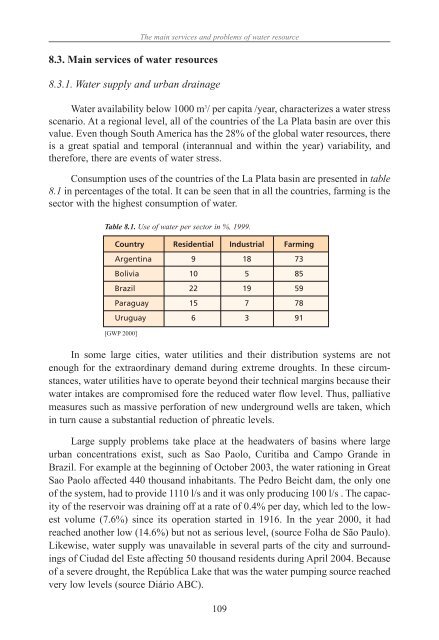chapter - Atmospheric and Oceanic Science
chapter - Atmospheric and Oceanic Science
chapter - Atmospheric and Oceanic Science
You also want an ePaper? Increase the reach of your titles
YUMPU automatically turns print PDFs into web optimized ePapers that Google loves.
The main services <strong>and</strong> problems of water resource<br />
8.3. Main services of water resources<br />
8.3.1. Water supply <strong>and</strong> urban drainage<br />
Water availability below 1000 m 3 / per capita /year, characterizes a water stress<br />
scenario. At a regional level, all of the countries of the La Plata basin are over this<br />
value. Even though South America has the 28% of the global water resources, there<br />
is a great spatial <strong>and</strong> temporal (interannual <strong>and</strong> within the year) variability, <strong>and</strong><br />
therefore, there are events of water stress.<br />
Consumption uses of the countries of the La Plata basin are presented in table<br />
8.1 in percentages of the total. It can be seen that in all the countries, farming is the<br />
sector with the highest consumption of water.<br />
Table 8.1. Use of water per sector in %, 1999.<br />
Country Residential Industrial Farming<br />
Argentina 9 18 73<br />
Bolivia 10 5 85<br />
Brazil 22 19 59<br />
Paraguay 15 7 78<br />
Uruguay 6 3 91<br />
[GWP 2000]<br />
In some large cities, water utilities <strong>and</strong> their distribution systems are not<br />
enough for the extraordinary dem<strong>and</strong> during extreme droughts. In these circumstances,<br />
water utilities have to operate beyond their technical margins because their<br />
water intakes are compromised fore the reduced water flow level. Thus, palliative<br />
measures such as massive perforation of new underground wells are taken, which<br />
in turn cause a substantial reduction of phreatic levels.<br />
Large supply problems take place at the headwaters of basins where large<br />
urban concentrations exist, such as Sao Paolo, Curitiba <strong>and</strong> Campo Gr<strong>and</strong>e in<br />
Brazil. For example at the beginning of October 2003, the water rationing in Great<br />
Sao Paolo affected 440 thous<strong>and</strong> inhabitants. The Pedro Beicht dam, the only one<br />
of the system, had to provide 1110 l/s <strong>and</strong> it was only producing 100 l/s . The capacity<br />
of the reservoir was draining off at a rate of 0.4% per day, which led to the lowest<br />
volume (7.6%) since its operation started in 1916. In the year 2000, it had<br />
reached another low (14.6%) but not as serious level, (source Folha de São Paulo).<br />
Likewise, water supply was unavailable in several parts of the city <strong>and</strong> surroundings<br />
of Ciudad del Este affecting 50 thous<strong>and</strong> residents during April 2004. Because<br />
of a severe drought, the República Lake that was the water pumping source reached<br />
very low levels (source Diário ABC).<br />
109






